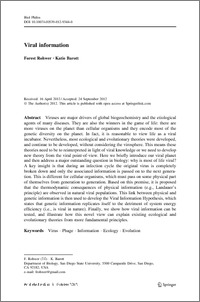Rohwer, Forest and Barott, Katie
(2012)
Viral Information.
In: UNSPECIFIED.
![[img]](https://philsci-archive.pitt.edu/style/images/fileicons/application_pdf.png)  Preview |
|
PDF
Rohwer_and_Barott_-_Viral_Information_2012.pdf
- Published Version
Download (453kB)
|
Abstract
Viruses are major drivers of global biogeochemistry and the etiological agents of many diseases. They are also the winners in the game of life; there are more viruses on the planet than cellular organisms and they encode most of the genetic diversity on the planet. In fact, it is reasonable to view life as a viral incubator. Nevertheless, most ecological and evolutionary theories were developed, and continue to be developed, without considering the virosphere. This means these theories need to be to reinterpreted in light of viral knowledge or we need to develop new theory from the viral point-of-view. Here we briefly introduce our viral planet and then address a major outstanding question in biology: why is most of life viral? Key insight is that during an infection cycle the original virus is completely broken down and only the associated information is passed on to the next generation. This is different than cellular organisms, which must pass on some physical part of themselves from generation to generation. Based on this premise, it is proposed that the thermodynamic consequences of physical information (e.g., Landauer's principle) are observed in natural viral populations. This link between physical and genetic information is then used to develop the Viral Information Hypothesis, which states that genetic information replicates itself to the detriment of system energy efficiency (i.e., is viral in nature). Finally, we show how viral information can be tested, and illustrate how this novel view can explain existing ecological and evolutionary theories from more fundamental principles.
Monthly Views for the past 3 years
Monthly Downloads for the past 3 years
Plum Analytics
Altmetric.com
Actions (login required)
 |
View Item |



